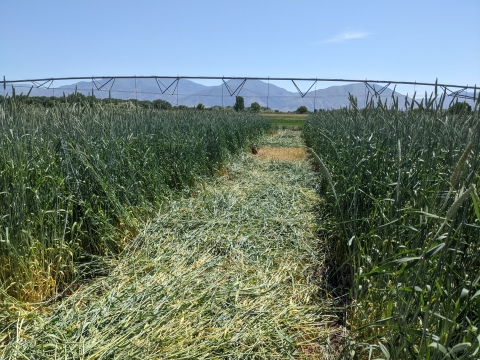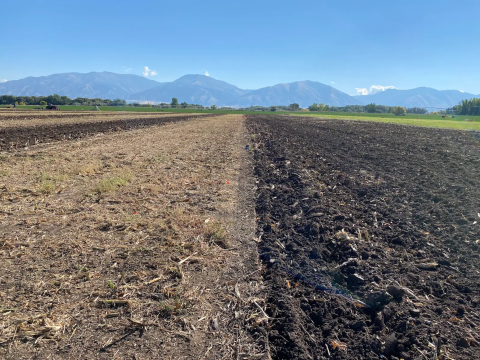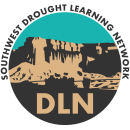Location
States
UtahEcosystem
PrairieIntroduction
The Colorado River Basin (CRB) supplies water to over 40 million people, and irrigation for approximately 5 million acres of farmland in seven western states (Richter et al., 2024). In 2022, two of the largest reservoirs in the CRB, Lake Mead and Lake Powell, decreased to 27% of capacity, resulting in a 50% decrease in electricity generation (Smith, 2023). The severe decline in the reservoirs is partly due to a 10% annual overdraw of water, and the mega-drought of 2001 to 2021 (Bass et al., 2023; Richter et al., 2024). In response to the declining availability of water in the CRB, the Bureau of Reclamation (BOR) called for a 2-4 million-acre-feet of additional savings for the entire basin during 2023-2026 to sustain Lake Mead and Lake Powell volumes prior to the post-2026 revised river compacts (Stern et al., 2024). As an upper basin state, nearly half of Utah’s irrigation is supplied by the Colorado River, supporting 400,000 acres of farmland (JQL Institute for Land, Water, and Air at USU). Utah has a 23% share of the 7.5 million acre ft allocated to the upper basin. Thus, to be in compliance with the BOR call for reductions, Utah may need to decrease its consumption from the CRB by several hundred thousand acre feet of water. This represents a large portion of the water currently used for agriculture. In addition to the CR, many irrigators in Utah rely on water in the Great Salt Lake basin where recent and historic droughts are also putting extreme pressure on water managers. In 2022, the Great Salt Lake was at a historic low elevation, magnifying the urgency for better water conservation measures (Utah Division of Water Resources, n.d.).
In response to ongoing and recent drought concerns, Utah State University (USU), Utah Water Conservancy Districts, BOR, Western Sustainable Agriculture Research and Education (SARE), and Natural Resources Conservation Service (NRCS) have partnered to research water optimization practices that also maintain crop yields and are cost-effective. This long-term research project focuses on four areas: irrigation systems, irrigation management, crops, and soils- both in isolation and in combination - to see which efforts produce the best results. The research began in 2019, and researchers hope to complete at least 10 years to produce a long-term study on irrigation management and how it can be combined with other techniques.
Key Issues Addressed
Nearly three-fourths of Utah’s diverted water is used for agriculture, and alfalfa used for forage for cattle accounts for half of all irrigated cropland. This is reflective of water usage for agriculture in other parts of the CRB (Dunphey, 2024). Despite the heavy water usage, many Utahans want to expand the thriving agricultural industry in their state. Agriculture was the first industry in the state and has grown to 18,000 farms covering over 11 million acres, supplying 80,000 jobs (JQL Institute for Land, Water, and Air at USU, 2002). Citizens largely support investing in water-efficiency improvements on farms, and the Utah Department of Agriculture and Food is investing over $270 million in the state’s Agricultural Water Optimization Program.
To best use the funding for water optimization, farmers and water managers need to understand which aspects of irrigation management should be invested in, and which steps farmers should take first. Currently, there are no long-term studies on irrigation systems to help inform management. There is a lack of knowledge on how irrigation management and technologies can be combined to conserve water without significantly impacting crop yields, in both the current and next growing season. Similarly, farmers would benefit from research on how to optimize water use by combining irrigation management techniques with crop and soil management, such as drought-tolerant crops.
Due to regional drought, it is not unusual for irrigation to be restricted or cut off entirely. These conditions sometimes necessitate deficit irrigation, in which farmers do not provide the crops’ total water needs, and instead ration irrigation water. Deficit irrigation research is sparse in Utah and farmers are looking for ideal deficit strategies that maintain yields of marketable crops when water availability is insufficient.
Additionally, farmers need to feel empowered to incorporate water optimization techniques. For the research to be applicable to farmers in Utah and the greater CRB, researchers studied methods that are cost effective, easy to implement, and include marketable crops. To empower farmers, researchers are incorporating them in the research trials, and communicating the results through demonstrations and workshops.
Project Goals
- Optimize agricultural water use in Utah to increase agricultural resiliency and sustain adequate water supplies in the CRB and GSL.
- Study the ability of different irrigation systems and management strategies, in isolation and in combination, to reduce water consumption while still maintaining long-term yields and cost effectiveness for farmers.
- Test the water optimization potential of lowering sprinklers on center pivot irrigation systems, while still maintaining crop production. Compare water use and crop production of mid-elevation (5-6 ft off ground) spray application (MESA) sprinklers, three low-elevation (~ 2 ft off ground) sprinklers (LESA, LEPA, LENA), and mobile drip irrigation (MDI).
- Combine sprinkler technologies with four different irrigation rates, totalling 16-20 treatments, to discover which technology and strategy combinations can decrease water use while maintaining production of alfalfa, corn, and small grains. Compare water use and crop production of season-long deficit irrigation, irrigating at 75% and 50% of crop total water needs, and 50% irrigation applied only during critical stages in crop development.
- Communicate water optimization tools and strategies by incorporating farmers into research trials, and creating education materials and tools such as an irrigation technology cost/benefit calculator.
Project Highlights
- Research in Diverse Environments: USU researchers established three water optimization trials on farms diverse in climate and soils: the first in 2019 in the Great Salt Lake basin, the second in the CR basin in 2020, and a third in an area with groundwater concerns in 2021. The research trials include 16-20 different irrigation strategies, 60 acres, and over 2,000 plots for data collection.
- Height of Center Pivot Sprinklers Affects Water Loss: The three low-elevation sprinklers (LESA, LEPA, and LENA) often maintained crop yield with 25% less water than MESA. Mobile drip irrigation often reduced crop yields when less irrigation was applied, likely due to plugging and associated issues with drip tubing.
- Season-LongDeficit Irrigation Simpler in Long-Run: During the trials of the impacts of different irrigation rates, the yield reduction amount corresponded to the irrigation reduction amount for all crops (Yost et al., 2021). Year-long reduced irrigation results in the same yields as targeted reduction, meaning it may be simpler for farmers to deficit irrigate all growing season instead of target-irrigating. However, partial season irrigation is likely more cost-effective due to fewer harvests.
- Soil Moisture Sensors Optimize Water in Drought: In a separate set of trials on 12 farms in Utah during 2019-2021, researchers compared how farmers could optimize water use with three different technologies to schedule irrigation: 1) basing watering schedules on the local weather station, 2) soil moisture sensors, and 3) a commercial model FieldNet Advisor from Lindsay Irrigation that automates irrigation scheduling by using satellite and weather data. All three approaches were effective at reducing water use by an average of 10-15% (especially in wet years) and the soil moisture sensor most often had the greatest water savings among the three approaches.
- Small Grain Forage as Alternative in Drought Years: Researchers found that growing small grain forage, such as a three-way mix of wheat, barley, and oats, can be a more water efficient alternative crop to alfalfa and corn in drought years. Small grains consume less water and can be harvested earlier in the season. This means if farmers run out of water in July, they can still harvest a marketable crop.
- Empowering Farmers by Communicating Research: To empower farmers to adopt water optimization practices, researchers hosted guided tours, demonstrations, and in-person and virtual field days. The demonstrations included local growers who provided guidance on irrigation techniques to other farmers. The 2020 virtual tour had over 30 speakers and over 100 attendants, the majority of which were farmers and crop advisors. Every participant that evaluated the meeting indicated they would attend another in the future, and nearly all indicated significant knowledge gain.
Lessons Learned
Researchers have learned how farmers can employ irrigation technologies and management strategies to optimize water use on their farms. Despite the success of the soil moisture sensors, in only half of the trials did they save more water compared to scheduled irrigation based on farmers’ years of experience. This affirms that farmers’ experience is valuable, but soil moisture sensors could help optimize water use in extreme drought years.
The three low-elevation sprinklers often maintained yield and forage quality at reduced irrigation rates compared to MESA. However, there was no single system that performed best in every trial and year. This indicated that all three low-elevation sprinklers may be effective ways to reduce water use, and that field conditions should be considered when selecting systems. Additionally, researchers concluded investing in the regular maintenance of sprinkler systems saves water in the most cost-effective way, such as maintaining water pressure regulators, and may be a good starting point for farmers to decrease water consumption. Center pivots with sprinkler heads closer together can reduce water loss from evaporation and are a more affordable option than installing drip irrigation (Yost et al., 2022).
To maintain a research project of this size, researchers worked with volunteer farmers from local communities to harvest and till experimental fields. These farmers were enthusiastic about the research and helped share results with their peers. Even with the help of volunteers, researchers found difficulty in maintaining scientific experiments in real-world conditions. For example, during one year of severe drought, the team ran out of water at two farms.
Typically, grant funding only covers five years of research, at most; however, this project requires at least a decade of effort to fully understand treatment effects. Consequently, the team had to secure additional funding.
Promotional videos, news articles, and presentations helped increase awareness of the project and secure funding from The Foundation of Food and Agriculture Research and NRCS, as well as equipment needed for the research trials from local manufacturers of irrigation parts.
Next Steps
- Research and monitor impacts of different techniques in irrigation management and irrigation systems for another 4-5 years to understand decadal impacts of water optimization practices
- Research how soil management, such as different tilling methods and cover crops, can be combined with irrigation strategies to best optimize water use
- Hold future demonstrations and group tours to help inform farmers how they can start saving water relatively easily and cost effectively
Funding Partners
- Western SARE
- Utah State University
- Foundation for Food and Agriculture Research
- Natural Resources Conservation Service
- Bureau of Reclamation
Sources Referenced
- Bass et al. (2023). “ Aridification of Colorado River Basin’s snowpack regions has driven water losses despite ameliorating effects of vegetation.” Water Resources Research 59, e2022WR033454.
- Dunphey, K. (2024). “Where did all the water go? New study explores water use in the Colorado River basin.” States Newsroom.
- JQL Institute for Land, Water, and Air at USU. (2022). “Water optimization on Utah’s farms - USU Research Landscapes, August 2022.”
- Richter et al. (2024). “New water accounting reveals why the Colorado River no longer reaches the sea.” Communications Earth & Environment 5, 134.
- SARE. (2024). “Using less water by “Stacking” conservation practices.”
- Smith, J. (2023). “Colorado River crisis: How did the nation’s two largest reservoirs nearly go dry?” The Colorado Sun.
- Stern et al. (2024). “Management of the Colorado River: Water allocations, drought, and the federal role.” Congressional Research Service R45546.
- Utah Division of Water Resources. (n.d.). “Great Salt Lake.”
- Yost et al. (2021). “Long-term water optimization trials: Stacking conservation practices.”
- Yost et al. (2022). “Optimizing overhead irrigation systems.”
Contact
Matt Yost, Utah State University: Matt.yost@usu.edu
CART Lead Author
Jackelyn Alessi, Case Study Author, Drought Learning Network (DLN)
Suggested Citation
Alessi,J., R. (2024). “Irrigation Management Techniques to Optimize Water on Utah Farms.” CART. Retrieved from https://www.fws.gov/project/irrigation-management-optimize-water.
The DLN is a peer-to-peer knowledge exchange between climate service providers and resource managers, created to gather and share lessons learned from drought events to prepare for future events. The DLN partners with CART to develop Case Studies, with funding from the National Drought Mitigation Center for interns and coordination support from the USDA Southwest Climate Hub.






